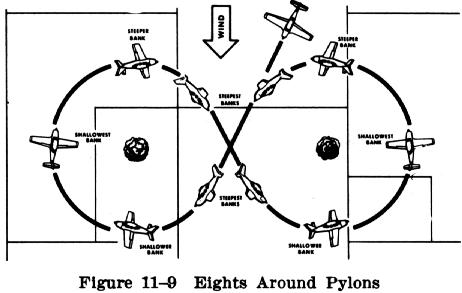
This training maneuver is an application of the same principles and techniques of correcting for wind drift as used in "turns around a point" and the same objectives as other ground track maneuvers. In this case, however, two points or "pylons" on the ground are used as references, and turns around each "pylon" are made in opposite directions to follow a ground track in the form of a figure "8" (Fig. 11-9). The pattern involves flying downwind between the pylons and upwind outside of the pylons. It may include a short period of straight and level flight while proceeding diagonally from one pylon to the other.

The pylons selected should be on a line 90 degrees to the direction of the wind and should be in an area away from communities, livestock, or groups of people, to avoid possible annoyance or hazards to others. The area selected should be clear of hazardous obstructions and other air traffic. Throughout the maneuver a constant altitude of at least 500 feet above the ground should be maintained.
The "eight" should be started with the airplane on a downwind heading when passing between the pylons. The distance between the pylons and the wind velocity will determine the initial angle of bank required to maintain a constant radius from the pylons during each turn. The steepest banks will be necessary just after each turn entry and just before the rollout from each turn where the airplane is headed downwind and the groundspeed is greatest; the shallowest banks will be when the airplane is headed directly upwind and the groundspeed is least.
The rate of bank change will depend on the wind velocity - the same as it does in "s turns" and "turns about a point" - and the bank will be changing continuously during the turns. The adjustment of the bank angle should be gradual from the steepest bank to the shallowest bank as the airplane progressively heads into the wind, followed by a gradual increase until the steepest bank is again reached just prior to rollout. If the airplane is to proceed diagonally from one turn to the other, the rollout from each turn must be completed on the proper heading with sufficient crab angle to ensure that after brief straight and level flight, the airplane will arrive at the point where a turn of the same radius can be made around the other pylon. The straight and level flight segments must, therefore, be tangent to both circular patterns.